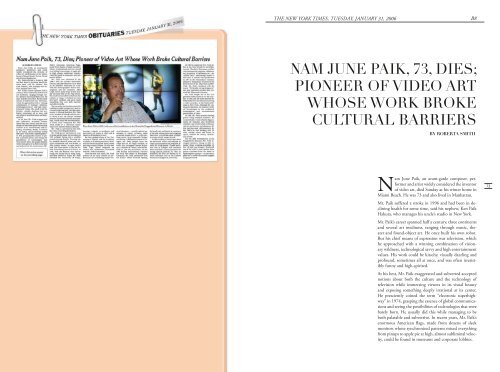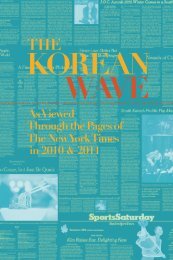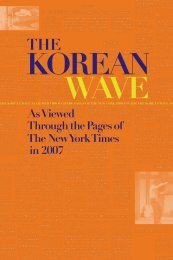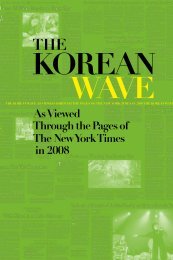The Korean Wave 2006 - Korean Cultural Service
The Korean Wave 2006 - Korean Cultural Service
The Korean Wave 2006 - Korean Cultural Service
Create successful ePaper yourself
Turn your PDF publications into a flip-book with our unique Google optimized e-Paper software.
<strong>The</strong> New York Times, tuesday, january 31, <strong>2006</strong><br />
B8<br />
Nam June Paik, 73, Dies;<br />
Pioneer of Video Art<br />
Whose Work Broke<br />
<strong>Cultural</strong> Barriers<br />
By ROBERTA SMITH<br />
Nam June Paik, an avant-garde composer, performer<br />
and artist widely considered the inventor<br />
of video art, died Sunday at his winter home in<br />
Miami Beach. He was 73 and also lived in Manhattan.<br />
Mr. Paik suffered a stroke in 1996 and had been in declining<br />
health for some time, said his nephew, Ken Paik<br />
Hakuta, who manages his uncle’s studio in New York.<br />
Mr. Paik’s career spanned half a century, three continents<br />
and several art mediums, ranging through music, theater<br />
and found-object art. He once built his own robot.<br />
But his chief means of expression was television, which<br />
he approached with a winning combination of visionary<br />
wildness, technological savvy and high entertainment<br />
values. His work could be kitschy, visually dazzling and<br />
profound, sometimes all at once, and was often irresistibly<br />
funny and high-spirited.<br />
At his best, Mr. Paik exaggerated and subverted accepted<br />
notions about both the culture and the technology of<br />
television while immersing viewers in its visual beauty<br />
and exposing something deeply irrational at its center.<br />
He presciently coined the term “electronic superhighway”<br />
in 1974, grasping the essence of global communications<br />
and seeing the possibilities of technologies that were<br />
barely born. He usually did this while managing to be<br />
both palatable and subversive. In recent years, Mr. Paik’s<br />
enormous American flags, made from dozens of sleek<br />
monitors whose synchronized patterns mixed everything<br />
from pinups to apple pie at high, almost subliminal velocity,<br />
could be found in museums and corporate lobbies.<br />
73





